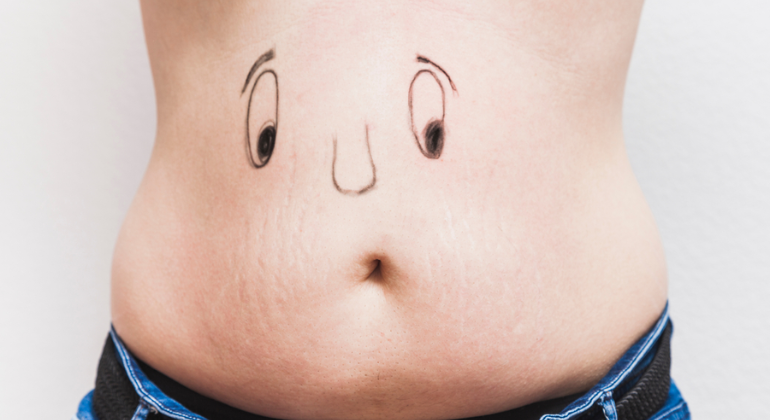Navel displacement, also referred to as nabhi displacement, is a condition where the navel (belly button) shifts from its natural central alignment. While it may sound like a minor issue, this misalignment can cause a range of problems, including abdominal pain, digestive discomfort, and muscle weakness. If left unaddressed, it could interfere with your daily activities and overall quality of life.
Navel displacement is often caused by poor posture, weak core muscles, or physical strain, but with the right knowledge and lifestyle changes, it’s preventable. This blog explores the main causes of navel displacement, explains how and why it happens, and provides natural prevention tips to help you avoid this condition in the future.
Causes of Navel Displacement
Navel displacement occurs when the balance of your abdominal muscles is disrupted. This imbalance can be caused by physical overexertion, digestive issues, or even everyday activities that strain the abdomen. Understanding these causes can help you take proactive steps to prevent this condition.
Key Triggers Include:
- Abrupt Movements: Sudden twisting or jerky movements can overstretch the abdominal muscles, causing the navel to shift out of alignment.
- Heavy Lifting Without Support: Improper lifting techniques, such as bending at the waist instead of the knees, put unnecessary strain on your core.
- Digestive Problems: Chronic bloating, gas, or constipation adds pressure to the abdominal area, weakening its structural integrity.
- Poor Posture: Sitting, standing, or sleeping in improper positions weakens the abdominal wall over time.
- Weak Abdominal Muscles: Without sufficient strength, your core muscles cannot hold the navel in its natural position.
By addressing these triggers, you can protect your abdomen and minimize the chances of navel misalignment. Let’s explore some specific reasons why navel displacement occurs.
Reasons for Navel Displacement

The reasons for navel displacement are often linked to the activities we perform daily. Whether it’s lifting heavy objects, running errands, or engaging in physical exercises, how you move and use your abdominal muscles plays a significant role in this condition.
Most Common Reasons Include:
- Lifting Heavy Objects Incorrectly:
- Many people lift heavy items without proper form, bending from their waist instead of their knees or failing to engage their core muscles. Over time, this leads to abdominal strain and misalignment.
- Example: Moving furniture, carrying groceries, or lifting gym weights without proper technique.
- High-Impact Activities:
- Activities such as running, jumping, or playing sports can overstretch the abdominal muscles, especially if you lack core stability.
- Example: Sudden directional changes during sports like tennis or soccer can cause navel displacement if your abdominal muscles aren’t strong enough to stabilize your core.
- Digestive Stress:
- Conditions like chronic bloating, gas, or constipation force your abdominal muscles to strain repeatedly, eventually leading to misalignment.
Preventive Actions:
- Use proper lifting techniques: Always bend your knees and engage your core while lifting.
- Strengthen your core muscles to improve stability during high-impact activities.
- Maintain a healthy diet to prevent bloating and constipation, which puts unnecessary stress on your abdomen.
Why Does Navel Displacement Happen?
Navel displacement happens when abdominal muscles lose their ability to support the navel’s natural position. This could occur due to repetitive strain, muscle weakness, or chronic digestive issues.
How It Happens:
- Muscle Strain: Abrupt or repeated movements, such as twisting or jerking, overstretch the abdominal muscles, compromising their stability.
- Digestive Pressure: Chronic constipation or bloating puts constant pressure on the abdominal wall, which can weaken the muscles over time.
- Core Weakness: Without a strong core, the navel becomes more prone to shifting due to everyday activities or even minor physical exertion.
Understanding the Process:
Imagine your abdominal muscles as the foundation that holds your navel in place. When these muscles are overworked, weakened, or strained, they lose their ability to stabilize the navel, resulting in displacement.
Steps to Avoid Displacement:
- Incorporate core-strengthening exercises such as planks, bridges, and leg raises into your fitness routine.
- Avoid activities that require sudden, jerky movements.
- Focus on improving digestion by staying hydrated and eating fiber-rich foods.
What Causes Navel Displacement in Adults?
Adults are particularly vulnerable to navel displacement due to lifestyle factors, age-related changes, and digestive health issues. As we age, the risk of misalignment increases due to muscle weakening and a more sedentary lifestyle.
Specific Adult Triggers Include:
- Weakening Muscles with Age:
- Over time, muscle mass naturally decreases if it’s not maintained through exercise. Weak abdominal muscles cannot provide adequate support for the navel’s alignment.
- Sedentary Habits:
- Many adults spend long hours sitting at desks or in front of screens, leading to poor posture and inactive core muscles.
- Digestive Issues:
- Adults are more likely to experience chronic bloating, constipation, or gas, which places extra strain on the abdomen.
- Weight Changes:
- Sudden weight gain or loss can destabilize the abdominal wall, increasing the risk of displacement.
Preventive Actions for Adults:
- Strengthen your core through regular exercise, such as pilates, yoga, or resistance training.
- Avoid sitting for prolonged periods; take breaks to stretch and move.
- Maintain a balanced diet rich in fruits, vegetables, and probiotics to support digestion.
Common Causes of Navel Misalignment
Some causes of navel misalignment are more frequent and widely experienced than others. Knowing these triggers can help you identify and address them in your daily routine.
The Most Common Causes Are:
- Heavy Lifting Without Core Engagement:
- Lifting without engaging your core muscles can overstretch your abdomen, leading to misalignment.
- Poor Posture:
- Slouching while sitting or standing places uneven pressure on the abdominal wall, causing chronic strain.
- Digestive Problems:
- Bloating and constipation repeatedly stretch the abdominal area, weakening its structure.
- Weak Core Muscles:
- Without proper strength, your core cannot stabilize your abdomen effectively.
- Sudden Physical Movements:
- Jerking or twisting your body abruptly can overstretch your abdominal muscles, increasing the likelihood of misalignment.
Preventing Navel Displacement Naturally

Prevention is the best strategy when it comes to navel displacement. By adopting healthy habits and focusing on core strength, you can minimize the risk of misalignment.
5 Natural Ways to Prevent Navel Displacement:
- Build Core Strength:
- Practice exercises such as planks, bridges, and yoga poses to keep your abdominal muscles strong and stable.
- Lift with Proper Form:
- Always bend your knees, engage your core, and lift with your legs instead of your back.
- Maintain Good Posture:
- Sit and stand with your spine aligned, and use ergonomic chairs to support your posture.
- Support Digestion:
- Eat a high-fiber diet to prevent constipation and bloating. Include probiotics like yogurt, kimchi, or sauerkraut to improve gut health.
- Stay Active:
- Avoid prolonged sitting by incorporating regular movement into your day. Even a 5-minute walk can activate your core and prevent stiffness.
Conclusion
Navel displacement can cause discomfort, but with the right knowledge and preventive measures, it’s possible to avoid it entirely. By focusing on core strength, maintaining proper posture, and improving digestive health, you can reduce the risk of misalignment and keep your body in balance.
If you’re experiencing symptoms of navel displacement or need expert guidance, contact Painflame today. Our team specializes in personalized care and holistic recovery plans designed to help you regain strength and mobility.
Take the first step toward a pain-free life—contact Painflame now!
Recent Blog : Best Food to Eat for Navel Displacement Recovery
Frequently Asked Questions (FAQs)
Nabhi displacement check karne ka koi simple tareeka hai?
Haan, ek simple test aap ghar par try kar sakte hain. Seedhe flat surface par let jaaiye aur navel area ko gently press kijiye. Agar uneven feel ho raha hai, ya dard ho raha hai, to ho sakta hai ki nabhi shift ho gayi ho. Lekin accurate diagnosis ke liye expert consultation zaroori hai.
Kya nabhi displacement ka digestion par bhi effect padta hai?
Yes, kyunki nabhi aur digestive system interconnected hote hain. Agar nabhi displacement ho jaye, to bloating, constipation, gas aur acidity jaise issues ho sakte hain. Kai log appetite loss aur irregular bowel movements bhi experience karte hain.
Navel displacement ke liye best natural remedies kya hain?
Agar mild case ho to gentle abdominal massage, core-strengthening yoga like Naukasana, Mandukasana aur ajwain-pani ya hing-pani ka सेवन digestion aur nabhi balance maintain karne me help kar sakta hai. Lekin agar problem frequent ho, to expert guidance lena best hai.
Kya nabhi bar-bar shift ho sakti hai?
Haan, agar aap incorrect posture me baithte hain, heavy objects bina proper support ke lift karte hain ya weak core muscles rakhte hain, to nabhi frequently shift ho sakti hai. Proper lifestyle changes aur physiotherapy se ye problem permanently control ki ja sakti hai.
Nabhi displacement aur hernia me kya difference hai?
Dono conditions different hain. Nabhi displacement ek muscular misalignment hota hai, jo correct exercises aur therapy se thik ho sakta hai. Hernia ek medical condition hai jisme intestine ya tissue weak abdominal wall se protrude karne lagta hai. Hernia me visible bulge, severe pain aur surgery requirement ho sakti hai, jabki nabhi displacement mostly non-surgical methods se treat kiya ja sakta hai.







